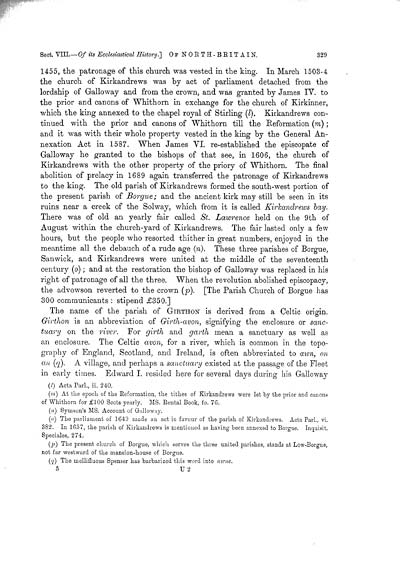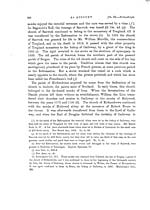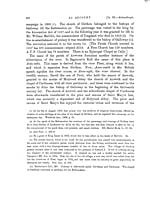Volume 5
(336) Page 329
Download files
Individual page:
Thumbnail gallery: Grid view | List view

329 1455, the patronage of this church was vested in the king. In March 1503-4 the church of Kirkandrews was by act of parliament detached from the lordship of Galloway and from the crown, and was granted by James IV. to the prior and canons of Whithorn in exchange for the church of Kirkinner, which the king annexed to the chapel royal of Stirling (l). Kirkandrews con- tinued with the prior and canons of Whithorn till the Reformation (m); and it was with their whole property vested in the king by the General An- nexation Act in 1587. When James VI. re-established the episcopate of Galloway he granted to the bishops of that see, in 1606, the church of Kirkandrews with the other property of the priory of Whithorn. The final abolition of prelacy in 1689 again transferred the patronage of Kirkandrews to the king. The old parish of Kirkandrews formed the south-west portion of the present parish of Borgue; and the ancient kirk may still be seen in its ruins near a creek of the Solway, which from it is called Kirkandrews bay. There was of old an yearly fair called St. Lawrence held on the 9th of August within the church-yard of Kirkandrews. The fair lasted only a few hours, but the people who resorted thither in great numbers, enjoyed in the meantime all the debauch of a rude age (n). These three parishes of Borgue, Sanwick, and Kirkandrews were united at the middle of the seventeenth century (o); and at the restoration the bishop of Galloway was replaced in his right of patronage of all the three. When the revolution abolished episcopacy, the advowson reverted to the crown (p). [The Parish Church of Borgue has 300 communicants : stipend �350.] The name of the parish of GIRTHON is derived from a Celtic origin. Girthon is an abbreviation of Girth-awn, signifying the enclosure or sanc- tuary on the river. For girth and garth mean a sanctuary as well as an enclosure. The Celtic avon, for a river, which is common in the topo- graphy of England, Scotland, and Ireland, is often abbreviated to awn, on an (q). A village, and perhaps a sanctuary existed at the passage of the Fleet in early times. Edward I. resided here for several days during his Galloway (l) Aeta Parl., ii. 240. () At the epoch of the Reformation, the tithes of Kirkandrews were let by the prior and canons of Whithorn for �100 Scots yearly. MS. Rental Book, fo. 76. (n) Symson's MS. Account of Galloway. (o) The parliament of 1649 made an act in favour of the parish of Kirkandrews. Acta Parl., vi. 382. In 1657, the parish of Kirkandrews is mentioned as having been annexed to Borgue. Inquisit. Speciales, 274. (p) The present church of Borgue, which serves the three united parishes, stands at Low-Borgue, not far westward of the mansion-house of Borgue. (q) The mellifluous Spenser has barbarized this word into awne. 5 U 2
Set display mode to:
![]() Universal Viewer |
Universal Viewer | ![]() Mirador |
Large image | Transcription
Mirador |
Large image | Transcription
Images and transcriptions on this page, including medium image downloads, may be used under the Creative Commons Attribution 4.0 International Licence unless otherwise stated. ![]()
| Caledonia, or, An account, historical and topographic of North Britain from the most ancient to the present times > Volume 5 > (336) Page 329 |
|---|
| Permanent URL | https://digital.nls.uk/74530796 |
|---|---|
| Description | Vol. V. |
|---|---|
| Attribution and copyright: |
|

